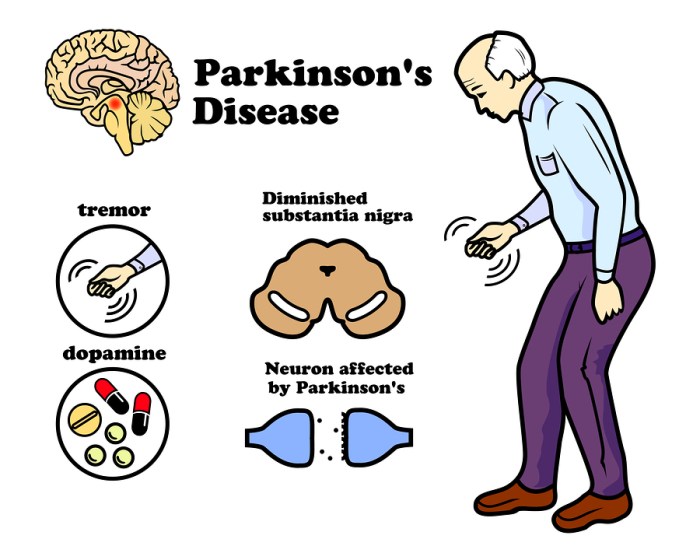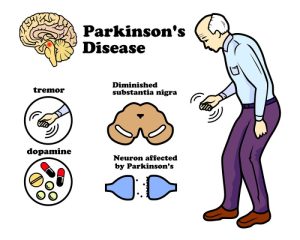
Exploring the realm of home care tips for individuals with Parkinson’s disease unveils a crucial aspect of their daily lives. From creating a safe environment to incorporating assistive devices and tools, these strategies play a pivotal role in promoting independence and well-being.
Let’s delve into the intricacies of providing effective care for those managing Parkinson’s disease.
Home Care Tips for People with Parkinson’s Disease
Parkinson’s disease is a neurodegenerative disorder that affects movement and coordination. It can impact daily life by causing tremors, stiffness, and difficulty with balance and walking. Managing symptoms and maintaining quality of life are essential for individuals living with Parkinson’s.Creating a safe and accessible home environment is crucial for individuals with Parkinson’s disease.
Adapting the home to accommodate mobility challenges and reduce fall risks can help prevent accidents and injuries. Simple modifications such as installing grab bars in the bathroom, removing tripping hazards, and improving lighting can make a significant difference.
Adapting the Home for Mobility Challenges
- Install handrails and grab bars in key areas such as the bathroom and stairways.
- Use non-slip mats and rugs to prevent slips and falls.
- Remove clutter and unnecessary furniture to create clear pathways for movement.
- Consider using a walker or cane for added stability and support.
Establishing a Structured Daily Routine
- Plan daily activities and tasks to provide structure and consistency.
- Include regular exercise, medication reminders, and meal times in the routine.
- Break tasks into smaller, manageable steps to avoid feeling overwhelmed.
- Allow time for rest and relaxation to manage fatigue and prevent burnout.
Assistive Devices and Tools
Individuals with Parkinson’s disease can benefit greatly from the use of assistive devices and tools to help them with daily activities. These devices are designed to improve independence, safety, and quality of life for patients.
Technology Integration in Home Care
Integrating technology into home care can significantly enhance the management of Parkinson’s disease. Here are some ways technology can assist:
- Medication Management: Smartphone apps with medication reminders and tracking features can help patients stay on schedule with their medication.
- Tremor Control: Wearable devices and specialized utensils can assist individuals in reducing tremors while eating or performing tasks.
- Communication: Speech-to-text apps and devices can aid in communication for patients who may have difficulty speaking clearly.
Selecting the Right Assistive Devices
When choosing assistive devices, it’s essential to consider the individual needs and preferences of the patient. Here are some tips for selecting the right devices:
- Consult with healthcare professionals to determine the specific challenges that need to be addressed.
- Trial different devices to see which ones work best for the individual’s comfort and usability.
- Consider the long-term benefits and durability of the device to ensure it will be effective in the long run.
Innovative Technologies for Parkinson’s Patients
There are various innovative technologies designed specifically to assist individuals with Parkinson’s disease. Some examples include:
- Smart walking canes with built-in sensors to prevent freezing episodes.
- Wearable devices that provide real-time feedback on movement and posture.
- Virtual reality therapy programs to improve balance and mobility.
Exercise and Physical Therapy

Regular exercise and physical therapy play a crucial role in improving mobility, balance, and overall quality of life for individuals with Parkinson’s disease. These activities can help manage symptoms such as rigidity and bradykinesia, ultimately enhancing independence and well-being.
Specific Exercises and Therapy Techniques
- Stretching exercises: Gentle stretching can help improve flexibility and reduce muscle stiffness.
- Aerobic exercises: Activities like walking, swimming, or cycling can enhance cardiovascular health and overall stamina.
- Balance training: Practicing balance exercises can reduce the risk of falls and improve stability.
- Strength training: Resistance exercises can help maintain muscle strength and prevent muscle atrophy.
- Cognitive therapy: Engaging in cognitive exercises can support mental acuity and cognitive function.
Tips for Creating a Personalized Exercise Routine
- Consult a physical therapist: Work with a professional to develop a tailored exercise plan based on individual needs and abilities.
- Set realistic goals: Establish achievable milestones to track progress and stay motivated.
- Stay consistent: Maintain a regular exercise schedule to maximize benefits and build endurance over time.
- Listen to your body: Pay attention to any discomfort or fatigue during exercise and adjust intensity accordingly.
Importance of Staying Active
Regular physical activity is essential for managing Parkinson’s disease symptoms, improving overall health, and enhancing quality of life. By staying active and engaging in exercise and physical therapy, individuals can experience increased mobility, independence, and a greater sense of well-being.
Nutrition and Meal Planning
Proper nutrition plays a crucial role in managing symptoms and medication effectiveness for individuals with Parkinson’s disease. Following a balanced diet can support overall health and well-being, as well as help in managing the condition effectively.
Guidelines for a Balanced Diet
- Include a variety of fruits, vegetables, whole grains, lean proteins, and healthy fats in your meals.
- Aim to limit processed foods, sugary snacks, and high-fat items to maintain a healthy diet.
- Stay hydrated by drinking an adequate amount of water throughout the day.
- Consider smaller, more frequent meals to manage any swallowing difficulties that may arise.
Supplements and Dietary Modifications
- Consult with a healthcare provider to determine if any supplements, such as Vitamin D or Omega-3 fatty acids, may be beneficial for your condition.
- Explore dietary modifications, like reducing dairy or gluten intake, to see if they have a positive impact on your symptoms.
- Keep track of how different foods and supplements affect your body and symptoms, and make adjustments accordingly.
Wrap-Up
In conclusion, implementing these home care tips can significantly impact the quality of life for individuals with Parkinson’s disease. By creating a safe home environment, utilizing assistive devices, engaging in physical therapy, and focusing on nutrition, it’s possible to enhance their overall well-being and independence.
Embracing these practices can truly make a difference in their daily lives.
FAQ Summary
How can I make my home safer for someone with Parkinson’s disease?
To create a safe environment, consider installing grab bars in bathrooms, removing tripping hazards, ensuring good lighting, and using non-slip mats.
What are some examples of assistive devices for Parkinson’s patients?
Examples include weighted utensils, button hooks, specialized keyboards, and devices for medication reminders.
How important is exercise for individuals with Parkinson’s disease?
Exercise plays a crucial role in managing symptoms, improving mobility, and enhancing overall quality of life for those with Parkinson’s disease.
What role does nutrition play in managing Parkinson’s symptoms?
Nutrition can impact symptoms and medication effectiveness, so maintaining a balanced diet is essential for individuals with Parkinson’s disease.





